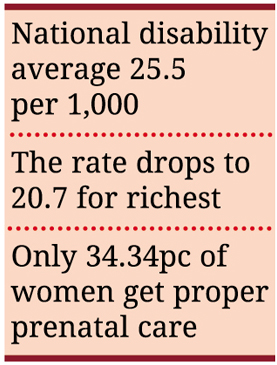
34.5 per 1,000 poorest Bangladeshis show signs of disability: Survey
SM NAJMUS SAKIB | Saturday, 10 February 2024
 The latest demographic surveillance system by the statistics bureau shows a grim disparity in disability prevalence across socioeconomic groups.
The latest demographic surveillance system by the statistics bureau shows a grim disparity in disability prevalence across socioeconomic groups.
Among the poorest communities, a whopping 34.5 per thousand individuals bear signs of disability, according to the Bangladesh Sample Vital Statistics 2022, as the rate exceeds the national average of 25.5 per thousand.
The survey, conducted by the state-owned Bangladesh Bureau of Statistics (BBS), points the finger at the lack of access to nutritious food and institutional healthcare faced by the poor for higher disabilities.
The study also compares the urban-rural divide, with urban communities exhibiting a lower prevalence of 23.2 per thousand compared to 26.2 per thousand in rural areas.
The Persons with Disability Rights and Protection Act defines "disability" as "a long-term or permanent physical, psychological, intellectual, developmental, or sensory impairment of a person."
The act recognises twelve specific types of disabilities, including autism spectrum disorders, physical disabilities, mental illness leading to disability, visual impairments, speech impairments, intellectual disabilities, hearing impairments, deaf-blindness, cerebral palsy, Down syndrome, multiple disabilities and others.
Illness and inadequate natal care have been identified as the leading causes of disability in the country, accounting for 64.1 per cent of cases combined. Of these, illness is responsible for 33.5 per cent, followed by genetic or natal factors at 30.6 per cent.
In preventing disability, public health specialists underscore the crucial role of maternal and child care before, during and after pregnancy.
They point to multiple nutritional deficiencies during pregnancy and breastfeeding, insufficient prenatal checkups and unsafe or absent institutional deliveries as major factors contributing to disabilities in babies.
According to the World Health Organization (WHO), all mothers and babies should have high-quality care throughout pregnancy, childbirth and the postpartum period.
The WHO recommends at least four visits to skilled health professionals during pregnancy.
However, according to the Bangladesh Bureau of Statistics (BBS) data published on January 31, only 34.34 per cent of women aged 15-49 who gave birth in 2022 received the recommended four antenatal care visits.
This rate is remarkably lower in rural areas, with only 28.90 per cent of mothers accessing adequate care, according to BBS.
The BBS survey also finds a link between the mother's education level and seeking antenatal care, aligning with international standards.
Professor Syed Abdul Hamid, health economist at Dhaka University, said the intake of nutritious foods is directly related to giving birth to a healthy baby.
However, financial constraints often prevent poor families in the country from completing the necessary prenatal checkups and accessing institutional deliveries, the told The Financial Express.
"Delivering at home with unskilled midwives can further increase the risk of disabilities in newborns."
Eminent gynaecologist Dr Gulshan Ara echoed Professor Hamid by saying multiple nutritional deficiencies are among the major causes of developing disabilities at birth.
"Deficiencies can hinder the physical and mental development of babies, both during pregnancy and breastfeeding and even through childhood," she added.
Both experts highlighted the shortage of skilled midwives in rural Bangladesh as a major contributor to the country's high disability rates.
Many women still give birth at home under the care of untrained midwives, increasing the risk of complications and disabilities. Over 3,260 government-run family welfare centres in rural areas reportedly lack dedicated midwife positions.
Dr Faizur Rahman, assistant director of the Medical Education and Family Welfare Division, Ministry of Health and Family Welfare, acknowledged some of the lackings in health services.
While emphasising proper nutrition, prenatal care and skilled delivery in preventing disabilities, he admitted the limitations faced by families due to economic constraints.
"We provide some basic natal care through rural health centres, including vitamins and iron tablets," Dr Rahman said. "However, we currently lack a government-designated midwife post at most of these centres. We rely on local NGOs to bridge the gap."
He added that a request for nearly 10,000 skilled midwives for union-level centres has been submitted to the health ministry.
According to the BBS survey, among reported disabilities, 11.1 per cent are classified as complete, 18.8 per cent as complex, 30.5 per cent as moderate and 36.2 per cent as partial or mild.
Mymensingh district has the highest disability rate at 30.3 per thousand, followed by Rajshahi at 28.6 per thousand. Sylhet division has the lowest prevalence, at 21.3 per thousand.